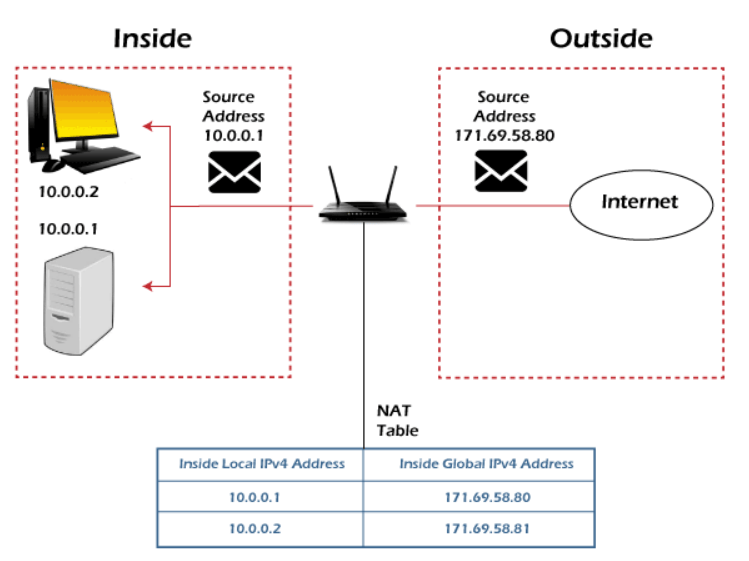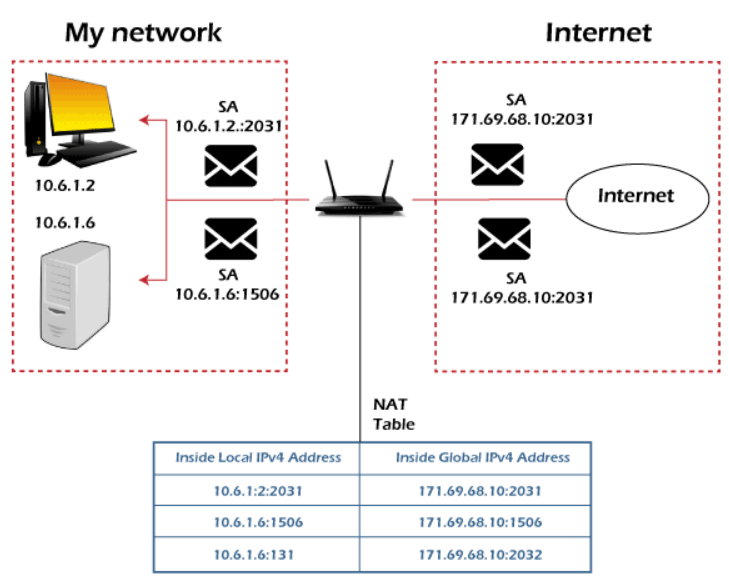Difference between NAT and PAT
Before transporting the packet, we can translate an unregistered private address (inside the local address of an internal network) to a registered public address (inside the global address of an external network) using the Network Address Translation (NAT) and Port Address Translation (PAT) protocols.
The main difference is that the public IP addresses are mapped to private IP addresses using NAT in one-to-one or many-to-one relationships. However, PAT is a type of NAT in which several private IP addresses (many-to-one) are mapped into a single public IP address via ports.
NAT(Network Address Translation)
Network Address Translation (NAT) converts private (within local) addresses into public addresses when two networks are connected (inside global). Inside local means that the best address was assigned by an internal network and not by a network information centre or service provider. A legitimate address assigned by the NIC or service provider and one or more inside the local addresses are indicated by the inside global and one or more inside local addresses, respectively.
NAT is a technique for transforming a local or private IP address into a public IP address. By converting a local or private IP address into a global or public IP address, NAT is a method for slowing the rate at which IP addresses are used up. The NAT relation can be one to one or many to one.
Additionally, NAT can only set up one address to serve as the exterior world's representation of the complete network. The translation process is therefore open. NAT can be used to move and combine networks, distribute server workloads, and set up virtual servers, among other things.

Different Types of NATs
There are three different types of NAT exist:
1. Static NAT
In static NAT, a local address is mapped to a global address. The relationship in this kind of NAT is one-to-one. If a host requires a constant address that must be accessed via the internet, static NAT is utilised. For instance, networking equipment or business servers.
2. Dynamic NAT
Dynamic NAT can be used to transform unregistered private IP addresses from a pool of public IP addresses into the registered public IP numbers.
3. PAT, NAT Overloading, and IP Masked
PAT is the most well-known of these three kinds. It is a variation of dynamic NAT but it converts several private IP addresses to a single public IP address via ports.
Benefits of NATs
The benefits of NAT are as follows:
- NAT safeguards registered public addresses and delays the expiration of the IP address space.
- It eliminates the renumbering of addresses that happens when moving networks
- Overlapped addresses are happened much less frequently.
- It increases the connection's establishment's adaptability.
Negative aspects of NAT
The drawbacks of NAT are as follows:
- End-to-end traceability is lacking.
- NAT is incompatible with several programs.
- Delay in switching paths result from the translation.
PAT (Port Address Translation)
We can configure address translation at the port level with Port Address Translation (PAT). It is a type of Dynamic NAT, while also optimising the use of the remaining IP addresses. From a pool of IP addresses that are routable on the destination network, PAT maps a variety of source local addresses and ports to a single global IP address and ports. Here, the port number is utilised in conjunction with the interface IP address, and because the port number is distinct, several hosts may have IP addresses that are similar.
It makes advantage of a distinctive source port address on the internal global IP address to distinguish between the various translations. The maximum number of NAT translations that can be carried out is 65536 because the port number is encoded in 16 bits.
The PAT maintains the original source. The available ports are looked for if the source port has already been assigned. Three ranges 0 to 511, 512 to 1023, and 1024 to 65535 make up the port groups.
If more than one external IPv4 address is configured and PAT is unable to identify an available port from the appropriate port group, it will attempt to assign the original source port until it runs out of both external IPv4 addresses and accessible ports.

Benefits of PAT
The benefits of PAT are as follows:
- It saves IP addresses by giving a single public IP address to a collection of hosts while using several port numbers.
- Security issues and security threats are reduced since the private address shields the public address from prying eyes.
Disadvantages of PAT
The drawbacks of PAT are as follows:
- To maintain track of connections, the internal table can only contain a limited number of entries.
- PAT prohibits running multiple instances of the same public service from the same IP address.